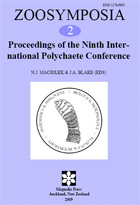Abstract
The artificial reef of Fregene, Italy, was built in 1981 as a multipurpose structure with the intent of protecting the coastal environment from illegal trawling and also improving fishery production. It is located at 10–14 m depth on a sandy-silty seabed in the Tyrrhenian Sea, 5 nmi north of the outlet of the Tevere River (Latium, Italy) and 1.5 nmi offshore the town of Fregene (Latium, Italy). The development of the polychaete community on the reef was studied from May 1981 to December 2001 in order to examine long-term community dynamics and verify to what extent changes in polychaete assemblage could depict the development of the benthic assemblage. At each sampling time, two standard surfaces of 400 cm2 were scraped from the vertical walls of the same block. Temporal changes in the development of the polychaete community were detected by univariate (S, N, ExpH', 1/Simpson, J') and multivariate (CLUSTER, nMDS) analysis of the faunal data. Functional structure of the community was also analyzed. Changes in the community structure were shown by an overall increasing trend in the total number of species and individuals. The 20-year development of the polychaete community was divided into five different phases representing different benthic assemblages on the reef: the first two periods correspond to settlement of pioneer species (1981–82); the third is a phase characterized by Mytilus galloprovincialis dominance and regression (1983–85); the fourth is a phase of mud accumulation between dead balanids, with the presence of laminar bryozoans (1991–92), and the last corresponds to a phase dominated by bryozoan bioconstruction (2001). The increased complexity in the benthic assemblage and substratum on the reef is also shown by an increased differentiation and distribution of polychaete functional groups. Increasing environmental heterogeneity on the reef is the basic factor that affected biodiversity by generating new niches that could be occupied by additional species with different ecology. The similarity of the benthic assemblage observed on the reef in 2001 with natural bioconstructions suggest that after two decades the ecological succession has lead to a settlement at a steady-state of equilibrium with the surrounding environment.

